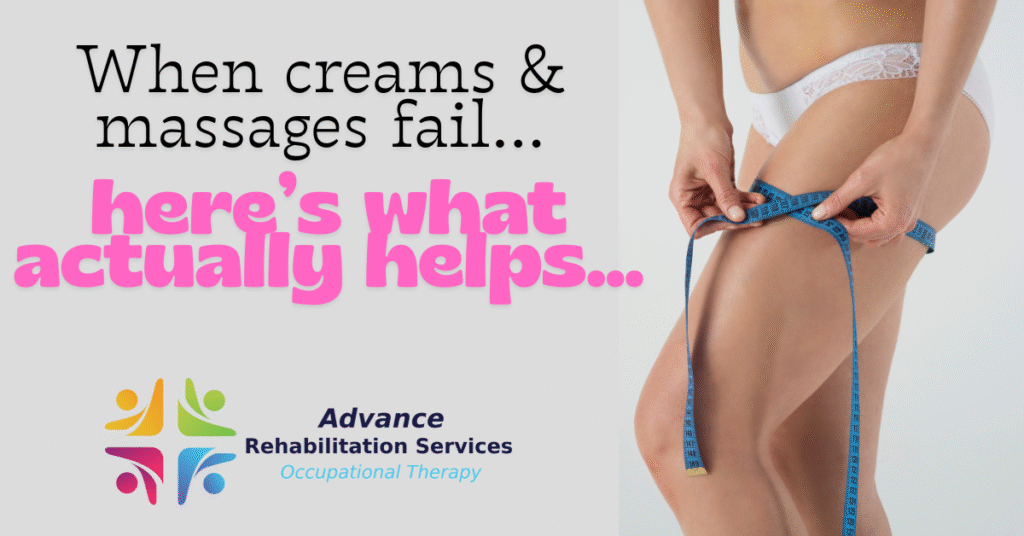At Advance Rehabilitation Services in Parsippany, New Jersey, we specialize in helping individuals understand and manage conditions that affect body composition and mobility. If you’ve been battling what you think is stubborn cellulite, but traditional cellulite reduction methods aren’t yielding results, it’s time to consider a different possibility: Lipedema.
Understanding Cellulite vs. Lipedema: Key Differences
Many people confuse lipedema with cellulite because both involve uneven fat distribution under the skin. However, they are distinct conditions. Cellulite is a common cosmetic issue where fat pushes through connective tissue, creating a dimpled, “orange peel” appearance, often on the thighs, buttocks, and abdomen. It’s influenced by factors like genetics, hormones, diet, and lifestyle, and affects up to 90% of women at some point.
Lipedema, on the other hand, is a chronic medical condition primarily affecting women, characterized by abnormal fat accumulation in the legs, hips, buttocks, and sometimes arms. This fat builds up in a “wrong” way—it’s disproportionate, painful, and resistant to diet and exercise. Unlike cellulite, lipedema fat is often nodular or lumpy, tender to the touch, and can lead to easy bruising. It typically spares the hands and feet, giving legs a “column-like” shape from hips to ankles.
If your body is storing fat unevenly—perhaps your upper body remains slim while your lower body expands despite your best efforts—you might not have just cellulite. This could signal lipedema, which is often misdiagnosed as obesity or simple swelling.
Why Cellulite Reduction Methods Fail for Lipedema
You’ve likely tried popular cellulite reduction techniques, hoping for smoother skin and reduced dimpling. Common approaches include:
- Topical creams and lotions: Products with caffeine, retinol, or aminophylline that promise to firm skin and reduce fat visibility.
- Massage therapies: Such as dry brushing, foam rolling, or professional lymphatic drainage to improve circulation and break down fat.
- Non-invasive treatments: Like radiofrequency, laser therapy, or cryolipolysis (fat freezing), which target superficial fat layers.
- Lifestyle changes: Dieting, cardio exercises, strength training, or even detox teas and supplements aimed at overall fat loss.
- Home remedies: Body wraps, coffee scrubs, or cupping to temporarily smooth the skin’s surface.
While these can help with true cellulite by improving skin elasticity and reducing minor fat deposits, they often fall short for lipedema. Why? Lipedema involves a deeper, pathological fat buildup that’s not responsive to standard weight loss or cosmetic fixes. The fat cells in lipedema are inflamed and fibrotic, making them resistant to breakdown. Continuing with ineffective cellulite reduction can lead to frustration, wasted time, and even worsened symptoms like increased pain or mobility issues.
Recognizing Lipedema Symptoms: When to Seek Help
Lipedema often emerges or worsens during hormonal shifts, such as puberty, pregnancy, or menopause. Key signs that your “cellulite” might actually be lipedema include:
- Painful fat deposits: Tenderness, aching, or heaviness in affected areas, especially after standing or light touch.
- Easy bruising: Skin that bruises from minor bumps, with a “mattress-like” texture.
- Disproportionate body shape: Slim upper body contrasted with enlarged, symmetrical lower body that doesn’t slim down with calorie restriction.
- Swelling that persists: Unlike regular edema, lipedema swelling doesn’t pit when pressed and may worsen over time.
- Emotional impact: Feelings of embarrassment or isolation due to body changes that don’t respond to typical advice.
If these resonate, it’s crucial not to dismiss them as just “bad cellulite.” Early diagnosis can prevent progression to advanced stages, where mobility is impaired or secondary lymphedema develops.

Effective Management for Lipedema: Beyond Cellulite Reduction
While there’s no cure for lipedema, targeted interventions can alleviate symptoms and improve quality of life. At our clinic, we emphasize a multidisciplinary approach:
- Conservative therapies: Compression garments to reduce swelling, manual lymphatic drainage (MLD) massage to promote fluid movement, and specialized exercises to support joint health without exacerbating pain.
- Nutritional guidance: Anti-inflammatory diets that focus on whole foods, though not as a sole “fix” for fat reduction.
- Advanced options: In some cases, tumescent liposuction specifically for lipedema, performed by experienced surgeons to remove diseased fat while preserving lymphatic function.
- Occupational therapy integration: Customized plans to enhance daily functioning, manage pain, and boost confidence through adaptive strategies.
Research shows that combining these methods can significantly reduce discomfort and improve body contour, far beyond what cellulite reduction alone offers.
Taking the Next Step
If cellulite reduction isn’t working and you suspect lipedema, consulting a specialist is key. Don’t let misdiagnosis hold you back—understanding your body’s unique needs can lead to real relief. For personalized evaluation and treatment options, contact Advance Rehabilitation Services in Parsippany, New Jersey, where our team is dedicated to empowering you on your wellness journey.

